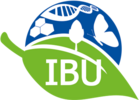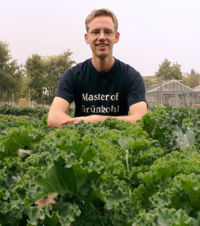Christoph Hahn
PhD thesis
Kale (Grünkohl) – Biodiversity in genes, chemistry and plant-herbivore interaction
Cabbage (Brassica oleracea L.) is a widely cultivated vegetable with important varieties in many parts of the world, especially Europe. The morphological variation ranges from white and red cabbage over broccoli, cauliflower, kale, kohlrabi, Brussels sprout to lesser known varieties. In this project, we focus on kale (B. oleracea var. sabellica L.), which is a valuable fresh vegetable during wintertime given its tolerance against frost. In general, kale is characterized by high levels of various nutrients and further constitutional metabolites like glucosinolates, having anticarcinogenic effects. One of the main question is whether kale constitutes a homogenous group or whether regional groups of kale can be distinguished phytochemically and genetically.
In this project we
- investigate different kale varieties from various origins and countries (like Northern Germany, Italy, USA and others) that differ in traits like growth height, shape, leaf color and curling,
- explore the variation of glucosinolates in ca. 50 varieties of kale using HPLC- and MS-techniques and test the influence of frost on these compounds,
- look at phylogenetic relationships of kale and cabbage using KASP-assay and SNP-array techniques,
- test the effect of these plants on generalist and specialist herbivores (mainly caterpillars).
We expect insights into the relationships of kale varieties, how they differ in their ability to synthesize different glucosinolates and how herbivory exerts influence on this, which cultivar contains the healthiest composition of compounds and which is most resistant to herbivory.
This project is part of the Research Training Group Interdisciplinary approach to functional biodiversity research (IBR)
Latest News
- The different shades of kale - New article about kale interrelations published.
- New contribution on TV series: "Land zwischen den Strömen – Von der Elbe bis zu Ems"
- Change of sugars in kale during acclimation to cold temperatures - new paper out now
- New TV report airing on ARTE: Xenius
- Follow us on Twitter @Gruenkohlforsch
- 5 facts about kale
- Overview (on page 2) of our kale research
- Rudolf Mansfeld Award 2017, awarded by the Gemeinschaft zur Förderung der Kulturpflanzenforschung Gatersleben e.V.
- New article in FOOD-Magazin: Grünkohl - ein zu wenig beachtetes Gemüse (siehe Publikationen)
- TV: NDR Visite (2.11.16) Gruenkohl wirkt vorbeugend gegen Krebs
- New publication out now (June 2016): Publication of Master thesis results
- TV: NDR Nordtour (21.11.15) Grünkohlsafari in Oldenburg
- Newspaper report: Weser-Kurier (8.11.15)
- Forscher züchten milde Sorte
Publications
- Hahn C., Howard N.P., Albach D.C. (2022): Different Shades of Kale – Approaches to Analyze Kale Variety Interrelations. Genes 13, no. 2: 232.
- Megías-Pérez R., Hahn C., Ruiz-Matute A. I., Behrends B., Albach D. C., & Kuhnert N. (2020): Changes in low molecular weight carbohydrates in kale during development and acclimation to cold temperatures determined by chromatographic techniques coupled to mass spectrometry. Food Research International 127, 108727.
- Hahn C. (2018): Die Vielfalt des Grünkohls - Warum Grünkohl nicht gleich Grünkohl ist. Kulturland Oldenburg 175: 2-3
- Albach D., Mageney V., Hahn C. (2017): Grünkohl - Ein zu wenig beachtetes Gemüse. FOOD-LAB 2/2017: 6-10
- Hahn C., Müller A., Kuhnert N., Albach D. (2016): Diversity of Kale (Brassica oleracea var. sabellica): Glucosinolate Content and Phylogenetic Relationships. J. Agric. Food Chem. 64: 3215-3225
- Hahn C., Albach D. (2013): Der Vergleich verschiedener Sorten des Grünkohls. Oldenburger Jahrbuch 113: 237-256
Conferences
- DBG Botanikertagung 2015, Poster Präsentation
- DBG Phylogenetisches Symposium 2016, Poster Präsentation
- GFBi-Jahrestagung 2017, Vortrag
- 21st Crucifer Genetics Conference BRASSICA 2018, Poster Präsentation
- Cocotea 2019 International Congress on Cocoa Coffee and Tea, Talk


